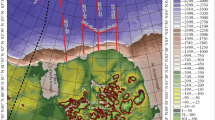Abstract
Southern Cyprus is situated within a mosaic terrane that has been fragmented between the northward drifting African and Arabian plates and the Eurasian plate. Enormous uplift of the earth mantle in the Tróodos Mountains is explained by two models. The subduction model explains subduction along the Cyprean arc to be the driving force for uplift whereas after the restraining bend model westward squeezing of Cyprus along strike-slip faulting is responsible for the enormous uplift at restraining bends. Since its emergence as an island in early Miocene times, landscape formation on Cyprus has been strongly controlled by this uplift. Until the Plio-Pleistocene, a strait belt separated the southern unroofed ophiolitic core region-the Tróodos Mountains-from the folded Kyrenia range to the north. This former sea basin, nowadays the Mesaoría Basin, is linked with the Tróodos Mountains by a dissected glacis with a thick cover of river deposits. The highest and oldest river deposits (Apalós Formation) were studied in the Vlokkariá hill southwest of Lefkosía. The 45.5 m thick Apalós Formation of Early Pleistocene age exhibits 24 sedimentary units (Fluviatile Series). Their magnetostratigraphical characters align with the Matuyama chron including the Olduvai and Jaramillo subchrons thus comprising about 1.15 Ma within the Early Pleistocene. This fluvial stack indicates a very flat and deeply lying river environment flowing from a slowly uplifting Tróodos hinterland. It happened during the end of Early Pleistocene when the enhanced Tróodos uplift started the dissection of the stacked river plain.
Similar content being viewed by others
References
Harrison R. W., Newell W. L., Batihanli H., Panayides I., McGeehin J. P., Mahan S. A., Özhür A., Tsiolakis E. et al., Tectonic framework and Late Cenozoic tectonic history of the northern part of Cyprus: implications for earthquake hazards and regional tectonics, J. Asian Earth Sc., 2004, 23, 191–210
Harrison R., Newell W., Panayides I., Stone B., Tsiolakis E., Necdet M., Batihanli H., Özhür A., et al., Bedrock geologic map of the greater Leftosia area, Cyprus. US Geol. Survey, Sci. Investigation Map, 2008, 3046, scale 1:25 000
Gass I. G., Masson-Smith D., The geology and gravity of the Troodos Massif, Cyprus. Philosophical Transactions Royal Society of London, 1963, A 255, 417–467
Kempler D., Ben-Avraham Z., The tectonic evolution of the Cyprean Arc, Annales Tectonicae, 1987, 1, 58–71
Robertson A. H. F., Tectonic evolution of Cyprus. In: Malpas J., Moores E. M., Panayiotou A., Xenophontos C. (Eds.), Ophiolites. Oceanic crustal analogues. Proceedings of the Symposium „Troodos 1987”. Geological Survey Department, Nicosia, 1990, 235–250
Robertson A. H. F., Tertiary uplift history of the Troodos massif, Cyprus, Geol. Soc. America Bull., 1977, 88, 1763–1772
Gass I. G., The Troodos massif: Its role in the unravelling of the ophiolite problem and its significance in the understanding of constructive plate margin processes. In: Panayiotou A. (Ed.): Ophiolites. Proceedings Intern. Ophiolite Symp. Cyprus 1979, Geol. Surv. Dep., Nicosia, 1980, 23–35,
McCallum J. E., Robertson A.H.F., Sedimentology of two fan-delta systems in the Pliocene of the Mesaoria Basin, Cyprus, Sediment. Geol., 1995, 98, 215–244
Ducloz C., Revision of the Pliocene and Quaternary stratigraphy of the Central Mesaoria. Annual Report Geol. Survey Dept. Cyprus 1964, Nicosia 1965
Newell W., Stone B., Harrison R., Tsiolakis E., Panayides I., Batihanli H., Necdet M., Berksoy et. al, Surficial geology of the Nicosia area. In: De-Coster M., Zomeni Z., Panyides I., Petrides G., Berksoy O. (Eds.), Seismic hazard and risk assessment of the greater Nicosia area. CD, Geological Survey Department, Nicosia, 2004, 40–59
Schirmer W., Die Talentwicklung an Main und Regnitz seit dem Hochwürm. Geol. Jahrbuch A, 1983, 71, 11–43, (in German)
Duck R.W., Application of the QDa-Md method of environmental discrimination to particle size analyses of fine sediments by pipette and sedigraph methods: a comparative study, Earth Surf. Proc. Land., 1983, 19, 525–529
Schirmer W., Zur Nomenklatur der Auenböden mitteleuropäischer Flussauen. Mitteilungen der deutschen bodenkundlichen Gesellschaft, 1991, 66, 839–842 (in German)
Weber J., Paläo- und gesteinsmagnetische Untersuchungen an fluviatilen Sedimenten der Lokalität Flokkarka, Zypern. Diplomarbeit Department für Geo- und Umweltwissenschaften der LMU München, 1991, (in German)
McFadden P.L., McElhinny M.W., Classification of the reversal test in palaeomagnetism. Geophys. J. Int., 1990, 103, 725–729
Berggren W.A., Hilgen F.J., Langereis C.G., Kent D.V., Obradovich J.D., Raffi I., Raymo M.E., Shackleton N.J., Late Neogene chronology;new perspectives in highresolution stratigraphy. Geol. Soc. Am. Bull., 1995, 107, 1272–1287
Heller F., Evans M.E., Magnetoklimatologie, Mineralmagnetismus und Eiszeiten. Naturwissenschaften, 1996, 83, 97–102 (in German)
Lord A.R., Panayides I., Urquhart E., Xenophontos, C., A chronobiostratigraphical framework for the Late Cretaceous-Recent circum-Troodos sedimentary sequence, Cyprus. In: Panayides J., Xenophontos C., Malpas J. (Eds.), Proceedings of the Third International Conference on the Geology of the Eastern Mediterranean. Geological Survey Department, Nicosia, 2000, 289–297
Schirmer W., Neogene submarine relief and Troodos uplift in southeastern Cyprus. In: Panayides J., Xenophontos C., Malpas J. (Eds.), Proceedings of the Third International Conference on the Geology of the Eastern Mediterranean. Geological Survey Department, Nicosia, 2000, 125–134
Author information
Authors and Affiliations
Corresponding author
About this article
Cite this article
Schirmer, W., Weber, J., Bachtadse, V. et al. Fluvial stacking due to plate collision and uplift during the Early Pleistocene in Cyprus. Cent. Eur. J. Geosci. 2, 514–523 (2010). https://doi.org/10.2478/v10085-010-0023-6
Received:
Accepted:
Issue Date:
DOI: https://doi.org/10.2478/v10085-010-0023-6



